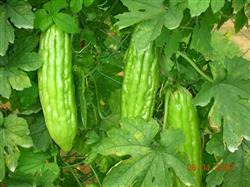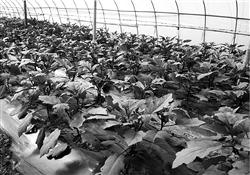Four key points of high-yield cultivation of spring balsam pear

Balsam pear fruit is rich in vitamin C, higher than tomato, and contains a glycoside with a special bitter taste, is one of the popular health vegetables. Planting spring balsam pear has the advantages of light disease, low cost, high yield and good benefit. The high-yield cultivation techniques of spring balsam pear mainly have the following four key points: selecting improved varieties and raising seedlings at the right time. High-yield, high-efficiency and high-quality hybrid varieties should be selected for spring planting balsam pear. Such as Changbai melon, Dabai balsam pear, Yuefeng No. 1, Green No. 2, emerald and so on. Sowing and raising seedlings when the daily average temperature is stable above 10 ℃. Strive for timely early sowing in order to prolong the vegetative growth period. Raise seedlings with a nutrition cup (bag) and choose a garden with a leeward to the sun, close to the water source and convenient management as a seedbed. First soak the seeds in warm water of 50-60 ℃, promote budding and dew white, gently press the root tip down, gently press into the nutrient soil, and build a 40cm-50cm arch bamboo frame, cover with film heat preservation and moisturizing, cold-proof and strong seedlings, uncover the film and refine the seedlings a week before transplanting. Apply enough base fertilizer and transplant at the right time. The base fertilizer is generally 1500 kg of mature farm fertilizer, 25 kg of phosphate fertilizer and 10 kg of potash fertilizer. The above fertilizers are evenly mixed and applied to the hole, and then covered with a thin layer of fine soil. Before sowing, the soil was prepared, the width of the border was 2 meters, two rows were planted in each row, the distance between rows was 120 cm, and the distance between holes was 40 cm. It was suitable to plant 1100-1400 plants per mu, transplanting when the seedlings had 3-4 true leaves, and applying light human feces and urine to make "marriage fertilizer" 3-5 days after transplanting. Set up a frame to draw the vine, the right time to topdressing. When the seedlings begin to draw the vine, the herringbone bamboo frame is used, and when the vine begins to climb, the vine should be tied and led to the shelf manually. After the vine is put on the shelf, the side vine extracted from the stem less than 40 cm is removed, and the over-dense old leaves and upper thin side vines are properly removed, ventilated and transparent. Topdressing with water and fertilizer is better, so as to apply frequently and thinly to promote early growth and rapid development of seedlings. After blooming and bearing melons, it is necessary to top fertilize once, generally using compound fertilizer 20,25kg per mu, and topdressing every 7 days during the melon picking period, which can prolong the melon harvest period. When the balsam pear fruit top is full, it can be harvested and listed on the market, and the melon is about 30 centimeters long. Timely prevention and control of diseases and insect pests. Adhere to the principle of comprehensive prevention and control of diseases and insect pests, do a good job in pastoral cleaning, timely drainage after heavy rain, and reduce the source of infection. Regular root irrigation of dioxone and Jinggangmycin was used to control Fusarium wilt of balsam pear. 600 times solution of chlorothalonil powder was used to control powdery mildew. 800-fold solution of trichlorfon was used to control diseases and insect pests such as melon and fruit flies. 1.1% nicotinamide EC was used 1000 times to control aphids and Liriomyza huidobrensis. It is found that Spodoptera litura is harmful to young Spodoptera litura, and the effect is good when the biological insecticide No. 1 is sprayed in time.
- Prev

Planting time and method of garlic
Planting time and method of garlic
- Next

There is a unique way to grow autumn eggplant.
The selected species are mainly Nile, Britta and Lang Gao, which belong to infinite growth type, early maturity, long fruit type, purplish black, green handle, green calyx, no thorns, smooth and bright texture. The single fruit weighs 300-400 grams and tastes good. Soak the seedlings in 50-55 ℃ warm water for 10-15 minutes before sowing seeds for 1-2 days.
Related
- Where is it suitable to grow horseradish in China? it is expected to see the middle altitude horseradish in Alishan.
- How to prevent tomato virus disease reasonably? (Control methods included)
- Many people like to plant towel gourd on the balcony. What are the main points of this method and management?
- What crops can chili peppers be mixed with?
- Fertilization techniques and matters needing attention in Tomato
- What are the grafting techniques for peach seedlings in spring?
- Harm and control methods of root swelling disease of Chinese cabbage
- What are the pests of sweet potatoes? How to prevent and cure it?
- Symptoms, causes and Control methods of navel Rot in Tomato
- The cause of "Cucumber rotten bibcock" in Farmers' planting Cucumber and its Control Plan

